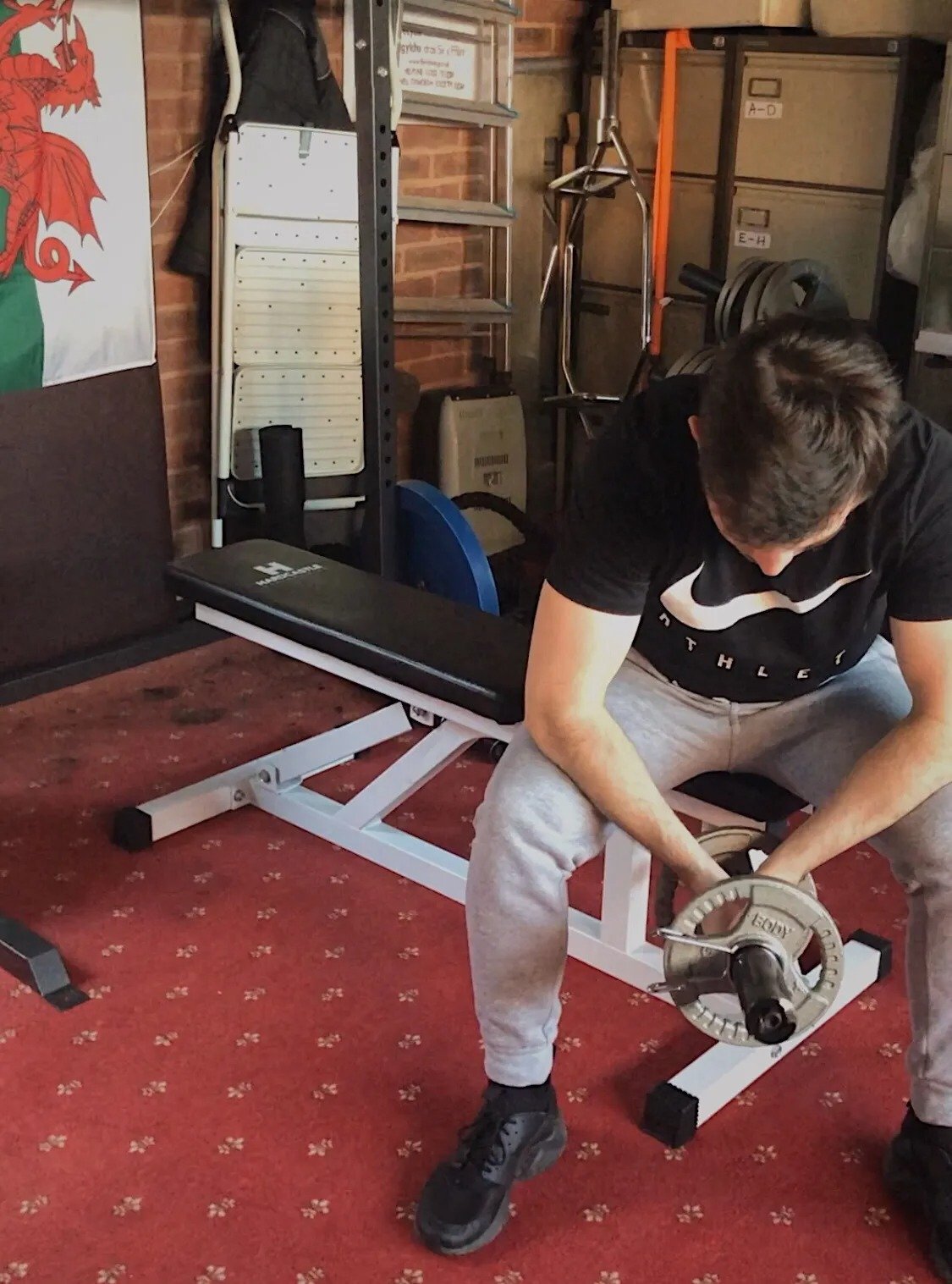Old school muscle: The Dumbbell Pullover
The dumbbell pullover – where do we start with this one?
1911 sounds like a good place. This was the year that pullovers were first introduced into the world by a bloke called Alan Calvert – a bit of a fitness buff at the time.
Shortly after their introduction, the dumbbell pullover took the fitness world by storm. It was used as the main upper body movement in many fitness programs of the time.
Have you ever heard of the infamous ‘squats and milk‘ workout routine? This would have lifters drink a gallon of milk every single day whilst performing 20 rep ‘breathing’ squats in their workouts (not at the same time).
Well, the dumbbell pullover was actually the other main movement that has since been taken out of the name – although it does still feature in the program itself.
This is because the pullover was so highly regarded as a full upper body movement that works in perfect unison with the squat. That’s some pedigree for an obscure exercise that has been cast aside by the gym rats of new isn’t it?
THE DUMBBELL PULLOVER
We’ve talked about the history of the lift but let’s get into the nitty gritty – the mechanics. Knowing about the mechanics behind the lift is key to understanding how to target certain areas and why different ways are better for different situations.
The pullover allows for the chest to placed in an optimal position and the stretch that you get from it affects the muscles in the same way that flyes do but with the added bonus of being able to load heavier weight for more reps.
At the bottom of the move, the stretch places a huge emphasis on the lats too, although once you lift the dumbbell past your head, this effect is lessened to some degree. It does still offer huge benefits for building a back like a barn door though as we will discuss a bit further down.
THE GREAT DEBATE
There is a debate that rages amongst the dumbbell pullover community. Well it’s less of a community and more just a few fellas arguing online about muscle activation.
But anyway…
Is it a chest or a lat movement? Well, it’s both. It just depends how you perform it. With that in mind, let’s break down how best to perform a dumbbell pullover for each.
Starting with the chest – this is a bit easier as the pullover does lend itself more towards chest activation. Having the dumbbell behind/above the body and bringing it to the front of the body is naturally a chest-dominant move. This is why so many old-school bodybuilders such as Arnold Schwarzenegger and Reg Park credit the dumbbell pullover for their amazing chest development.
All you have to do is really squeeze the pecs throughout the full movement as this is one of those exercises that actually requires that mind muscle connection. I hate saying that but it’s true. This will help to really empty the tank and isolate your pecs nicely.
Now for the lats. This is a little bit tougher but it’s not rocket science – you can still do it easily enough.
I’ll be honest with you, when I perform pullovers, I actually feel it more in my lats. This could be because I tend to hold the stretch at the bottom of the movement for about 2 seconds. As this is where the lats are most dominant, it could mean that I am getting a stronger mind muscle connection there. God I hate saying that so much.
All you have to do to really feel this in the lats is to get that stretch. Hold the bottom position for 2-3 seconds and focus on the contraction in your lats. Then, try to pull with your elbows like you would for rows – this allows for a clear focus on the back and will help burn the lats out nicely.
THE BENEFITS
The dumbbell pullover comes with so many benefits. It can be used at the begining or end of a workout, it can be a chest or a back exercise, it can be done low reps or high reps – it’s such a multi-faceted move.
Anyway, I’ve listed a few of these unique benefits below to whet your appetite.
The upper body squat
The dip is often touted as the upper body squat and with good reason – it basically is. However, I’d argue that the dumbbell pullover may just pip it to the post.
Just like squats working the lower body, pullovers work every last bit of the upper body. They work the chest, the back, the shoulders and to some degree – even the arms.
There’s a reason that this exercise was held in such high regard by thousands of bodybuilders from the golden era. The only reason it has fallen out of fashion is because so many people are simply afraid of hard work and are lacking the mobility to perform it due to their sedentary lifestyles.
Basically, you should build your mobility up and throw the dumbbell pullover into your routine, because otherwise, you’re missing out on some of the best upper body development you can possibly achieve.
The chest angle
This is a biggie.
With standard flyes, it’s quite hard to go heavy. In fact, I’d wager that it’s virtually impossible to go heavy. This is where the dumbbell pullover excels.
Obviously you don’t have to go heavy and it is more about getting a great stretch, but pullovers really allow you to load the stretch on your pecs so much more than flyes.
It is quite a unique stimulus for the chest as it is so used to pressing heavy loads usually as well as sometimes being placed under some stretch but never very heavy.
By adding this volume to your chest at such an alien angle, the pecs are forced to hypertrophy – which is always a good thing.
The lat angle
Weirdly, the dumbbell pullover is actually the only way to isolate your lats. It takes out a lot of the assistance work of all the other back muscles, forearms and even the biceps.
This is what makes it such a great pre-exhaustion exercise as it allows you to get the direct work in before doing heavier compound lifts where your other back muscles and biceps will share the load – taking emphasis off the lats.
AS FOR RIB CAGE EXPANSION…
The big selling point for dumbbell pullovers back in the day was that they expanded the rib cage. So, is this actually true?
No.
Obviously not you idiot. There’s no way to grow bone.
That was quite harsh wasn’t it? I shouldn’t have snapped on you like that – it won’t happen again I promise.
Anyway, like I say, dumbbell pullovers are no good for expanding the rib cage – nor is any exercise ever. However, they are fantastic for increasing all of the musculature around the ribs, which is what gives that look to the physiques of those who use them religiously.
So the answer really should be – no, they don’t expand the rib cage per se but they do cause hypertrophy in all of the areas surrounding the rib cage. So I guess the old timers were kind of right.
HOW TO DO IT
It’s a very simple move – when done correctly.
Lie down on a bench like you would for a bench press. Some people advocate lying across the bench but I think that’s a sub-par way of doing it. If you do want to do it that way obviously that’s okay but your hips may be robbing you of optimal muscle activation.
Once you’re lying down, bring a dumbbell up above your head with straight arms. Your palms should be facing up supporting the dumbbell and you should have a decent grip. Then you want to lower the dumbbell as far down as you can behind your head whilst keeping your arms as straight as possible (some bend is okay).
Once you’re at the bottom position, hold the stretch for a second or two – this is what will really give the lats a great workout. Then pull back up to the starting position, arms straight. The second portion will start as lat dominant and progress to chest dominant, meaning you’ll get a killer pump in your full upper body.
If that explanation hasn’t got through to you, just take a quick look at the video below.
WARNINGS
A lot of people hear ‘dumbbell pullover’ and say ‘what’s that?’ – the rest of the people that hear it will reply ‘nah mate, that’ll scupper your shoulders, I’m not doing it’.
Well they’re wrong – but sort of right. If you try pullovers without having adequate shoulder mobility then you’re asking for problems – as is the same with any other exercise.
All this means is that you have to test how well your shoulders can cope with the stress of being stretched. A simple test is to do a set of overhead press, rest, and then do a set of pullups.
If you can do a set of each with complete range of motion (and I mean complete – no cheating), then you have adequate shoulder mobility and should be able to perform the dumbbell pullover with ease.
If you can’t, then you should look at some shoulder mobility routines online and try again in a month or so. After a few goes, if you just can’t perform the exercise without discomfort then unfortunately, it may just not be for you.
HOW TO IMPLEMENT PULLOVERS CORRECTLY
There’s more than one way to skin a cat. The dumbbell pullover can be slotted perfectly into any routine but I’m going to give you three examples.
I do full body workouts three times per week – if you do this too, I’d recommend throwing them in at the end of each workout supersetted with dead hangs to get the ultimate stretch.
You can also use them as a pre-exhaustion exercise – I find this works particularly well before doing pullups as it really helps with lat activation.
But for those of you who split your workouts into, pushes, pulls, uppers, lowers and whatever else, here’s a few suggestions:
Push workout
Bench press – 3 x 5
Overhead press – 3 x 8
Dips – 3 x 10
Skullcrushers – 3 x 10
Dumbbell pullover – 3 x 15
Pull workout
Deadlift – 3 x 5
Dumbbell pullover – 3 x 15
Pullups – 3 x 8
Barbell rows – 3 x 10
Barbell curl – 3 x 10
Upper body workout
Bench press – 3 x 8
Pullups – 3 x 8
Dumbbell pullover – 2 x 15
Dips – 3 x 10
Barbell rows – 3 x 10
Dumbbell pullover – 2 x 15
The dumbbell pullover is easily one of the greatest upper body builders ever and should be treated as such by far more people than it is currently.
Throw these into your workouts once or twice a week and watch your chest and lats respond in an unbelievable manner. You’ll thank yourself and more importantly – me, in the long run.
Be sure to follow me on socials to keep up with the daily goings on of The Man Blueprint. You can also sign up for my inner circle using the newsletter form above. Just drop your email in there and it’s job done. Completely free and completely brilliant. Whilst you’re here, have a little browse of some other article you might like below too. You won’t regret it.
YOU MAY ALSO LIKE
Dead hangs: Exercise guide & Benefits
Dead hangs – doesn’t sound very exciting does it?
The benefits of this exercise certainly are though. Hanging on a bar is one of the easiest things you can do and the risk to reward ratio is better than any other exercise out there, hands down.
DEAD HANGS? WHAT’S IN IT FOR ME?
There’s quite a lot in it for you actually. I have listed some of the top benefits here but the improvements that dead hangs will offer you in the long run are far more detailed than these five points.
Spinal Decompression
The biggest draw when it comes to dead hangs is their proficiency at decompressing the spine. Hanging for just a few minutes per week can help to undo all the compression you put your spine under day in, day out from things like squatting in the gym, sitting all day and carrying heavy backpacks. This is great for spinal strength and can vastly improve your posture.
Grip strength
Another fantastic benefit that dead hangs offer is that they can turbocharge your grip strength. Having to hold onto the bar for far longer than you usually would forces your forearms to work overtime keeping you and the bar acquainted.
Over time as you build up your hang time and eventually add weight to the exercise, you will gain a vice-like grip that will carry over to your big lifts such as deadlifts, chin ups and rows.
Build huge forearms
An often overlooked benefit of dead hangs is that along with building mammoth grip strength, they also blow up your forearms. You’ll realise once you give these a go – doing 4 sets of dead hangs per week will blast your forearms 10x as hard as 10 sets of mindless forearm curls with 15kg barbells.
It’s a much more natural way to build mass and vascularity whilst adding transferable grip strength to your arsenal.
Rotator cuff strength
The rotator cuff is to a lifter what the metatarsal is to a footballer. These puppies are the main culprits when it comes to injuries in their respective practices. The rotator cuff is one of the most vulnerable muscles and is often injured due to an overload of pressing movements.
Because it isn’t a show muscle people tend to overlook it’s importance in favour of 5 extra sets of bench press. By doing a few sets of dead hangs you can stimulate the rotator cuff and proof them against strain and injury in the future – all whilst working a variety of other areas simultaneously.
Un-tightens lats
The final benefit that dead hangs posses is that they can stretch out and un-tighten the lats. The lats are crucial in pulling AND pushing movements so keeping them loose and healthy is key to skyrocketing your pressing exercises like bench press (where your lats do a large portion of the work) and overhead press.
It goes without saying that this will also carry over into your chins, dead lifts and rows. For the sake of a few minutes a week it looks like you’re getting some serious bang for your buck here doesn’t it?
HOW?
So, how exactly do you complete a dead hang?
Grab a pull up bar, totally disengage every muscle in your body and just hang onto the bar for as long as you can.
For your first go, record your max hang time.
After finding this, work out 70% of your max and use this as your ‘working weight’ to stop fatigue setting in and interfering with your other exercises. So you would do 2 sets of 70% of this time a few times a week after a workout.
Try to then add 5 seconds on to that time every month, retesting your max every 12 weeks.
Make sense?
CONCLUSION
Dead hangs are the easiest and most efficient exercise you’re not doing. Add them to the end of your workouts three times a week to decompress that spine, blast your forearms and super-strength your rotator cuffs. Try it for 12 weeks and see how much your performance and wellbeing come on.
Be sure to follow me on socials to keep up with the daily goings on of The Man Blueprint. You can also sign up for my inner circle using the newsletter form above. Just drop your email in there and it’s job done. Completely free and completely brilliant. Whilst you’re here, have a little browse of some other article you might like below too. You won’t regret it.
YOU MAY ALSO LIKE
Testosterone Boosting Carnivore Slow Cooker Chilli Recipe
Today I present to you a recipe that is not only easy to make, it’s incredibly tasty to boot. This is a slow cooker chilli with a twist, it is choc-full of testosterone boosting ingredients that lend themselves perfectly to muscle growth.
You’ll need a slow cooker, chopping board, knife, a tin opener and big ol’ spoon. The recipe yields 6 servings. Serve with rice to boost the calories and carb content if you wish. Sometimes I’ll add in tortilla chips as a treat that also takes the calories up way past 1,000 which is great if you’re looking to bulk up.
THE SLOW COOKER CHILLI
2kg lean mince (Beef, pork, turkey)
I tend to use beef here as the base for my slow cooker chilli as it has been shown on countless occasions to raise testosterone levels due its high levels of Zinc, Iron and vitamin b12. It also packs a serious punch when it comes to protein and healthy fats – both fantastic for T production.
4 cloves of garlic
Garlic is an amazing T booster due to its high levels of quercetin. This gives garlic anti-inflamatory properties and is also a very potent nitric oxide booster.
1 onion
Onions also contain quercetin which is fantastic for T production. This together with garlic may give you stinky breath but it’ll certainly put a little bit more hair on your chest so I’d say it’s worth it.
3 bell peppers
Bell peppers have got great T boosting vitamins and minerals including folate, vitamin C and potassium.
2 tins of kidney beans
All types of beans are great for health in general and pack a high amount of protein per gram. Just be sure to wash them before cooking or face the windy consequences.
1 tin of chopped tomatoes
This is mainly for the taste and a saucy base for the recipe. However tomatoes are actually a very healthy food which can aid in healthy hormonal function due to their high levels of vitamin A & B and fibre.
1 pack of chilli spice mix
This is mainly to add lots of taste to the dish BUT spices have been shown to aid in digestive health, hormonal health and brain function in the past, so load up on spices if you want to experience some great benefits.
3 large avocados
These fat bombs are amazing for testosterone production. They contain lots of Vitamin E, which is great but they are also full of Saturate and Mono-unsaturated fats which have been correlated with higher testosterone production and are without a doubt my favourite way of increasing my fat intake.
250g spinach
Spinach has got lots of magnesium, iron and vitamin b6 which all help to boost testosterone, increase nitric oxide and can also help protect against cancer.
250g rice (optional)
Rice is a fantastic way of getting in some much needed calories if you’re bulking, it also tastes brilliant with chilli.
50g tortilla chips (optional)
I love tortilla chips, they give that full-on mexican vibe to the meal and taste brilliant. If you can afford the extra couple of hundred calories then treat yourself. Nothing tops off a slow cooker chilli like some tortilla chip goodness.
COOKING
Cut up your veg & garlic & empty into the slow cooker.
Add in half the pack of spice mix & half the tin of chopped tomatoes.
Drain kidney beans & add into the slow cooker.
Add in the mince and the rest of the spice mix. Mix everything up.
Cook on low for 6-8hrs.
Whilst everything is cooking, evenly distribute spinach and avocado into 6 containers.
When it’s all cooked, divide into the 6 containers.
This recipe freezes well so put portions in the freezer if they’re not going to be consumed within the next couple of days.
Below is the macronutrient and micronutrient breakdown of the slow cooker chilli without rice or tortilla chips;
| Nutrition Facts | % Daily Value* |
| Servings 6.0 | |
| Amount Per Serving | |
| Calories 734 | |
| Total Fat 36 g | 55 % |
| Saturated Fat 8 g | 39 % |
| Monounsaturated Fat 0 g | |
| Polyunsaturated Fat 0 g | |
| Trans Fat 0 g | |
| Cholesterol 0 mg | 0 % |
| Sodium 361 mg | 15 % |
| Potassium 232 mg | 7 % |
| Total Carbohydrate 25 g | 8 % |
| Dietary Fiber 9 g | 37 % |
| Sugars 9 g | |
| Protein 72 g | 143 % |
| Vitamin A | 4 % |
| Vitamin C | 288 % |
| Calcium | 1 % |
| Iron | 3 % |
* The Percent Daily Values are based on a 2,000 calorie diet, so your values may change depending on your calorie needs. The values here may not be 100% accurate because the recipes have not been professionally evaluated nor have they been evaluated by the U.S. FDA.
Be sure to follow me on socials to keep up with the daily goings on of The Man Blueprint. You can also sign up for my inner circle using the newsletter form above. Just drop your email in there and it’s job done. Completely free and completely brilliant. Whilst you’re here, have a little browse of some other article you might like below too. You won’t regret it.












